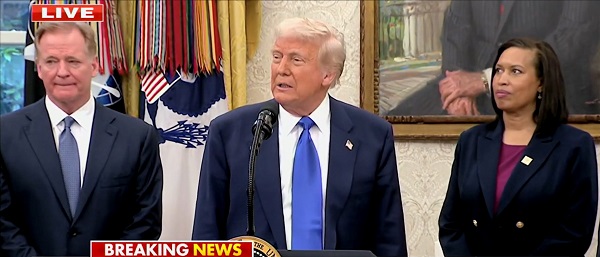Daily Caller
New York Dem Tells Adams It’s Time To Turn ‘Tough Talk’ On Immigration Into Action


From the Daily Caller News Foundation
By Jason Hopkins
New York City Mayor Eric Adams declared that he is willing to work with the Trump administration to help crack down on illegal migrant crime, but a fellow Democrat is pushing him to prove he means what he’s saying.
Adams said Tuesday that he is prepared to sit down with soon-to-be border czar Tom Homan to discuss the incoming administration’s plans to deport criminal illegal migrants out of the Big Apple, and he dared his opponents to “cancel me” if they aren’t happy with it. However, NYC Council Member Robert Holden, a Democrat and co-chairman of the moderate Common-Sense Caucus, responded by pushing the mayor to “show his commitment” by rolling back a number of sanctuary policies that are holding Immigration and Customs Enforcement (ICE) agents back.
“Tough talk is good, but actions speak louder,” Holden said in a Wednesday statement. “The Mayor had the chance to amend or repeal sanctuary city laws through his Charter Revision Commission but chose not to.”
“Now, it’s time to right these wrongs,” Holden continued. “To truly show commitment to public safety, Mayor Adams should reopen the ICE office at Rikers Island and give the NYPD, DOC [Department of Corrections], and DOP [Department of Probation] the ability to communicate with ICE and honor detainers for criminal migrants.”
NYC’s status as a sanctuary city has long been a contentious issue with local leaders, especially in recent months as a spate of high-profile crimes allegedly committed by illegal migrants have become national headlines.
Former Mayor Bill de Blasio in 2014 signed into law a bill that largely prohibits the New York Police Department from cooperating with federal immigration authorities, and he enacted legislation in 2018 that doubled down on the policy. A major facet of de Blasio’s sanctuary city rollout was the eviction of ICE agents from Rikers Island, a major prison facility located in The Bronx.
Barring ICE agents from prison facilities makes their job incredibly more difficult and dangerous because they are forced to make apprehensions of criminal migrants out in the public, federal immigration authorities argue.
NYC has been hit particularly hard by the national immigration crisis. Hundreds of thousands of asylum seekers have landed in the Big Apple since 2022 and officials have burned through billions of taxpayer dollars trying to manage the situation, according to city officials. The crisis has forced Adams to grow increasingly less sympathetic to the city’s sanctuary laws.
However, when Common Sense Caucus members introduced legislation earlier this year that would’ve rolled back sanctuary city legislation, it went nowhere in the NYC Council, which is dominated by liberal lawmakers. Members of the moderate caucus group said Adams could’ve done more to bring the issue to voters when he created the Charter Revision Commission, which had the authority to hand the decision to voters by placing it on the November ballot.
“The fact is that our city’s sanctuary city status has become deeply unpopular, even among Democrat voters, and was almost certain to be defeated by voters if a vote was allowed,” GOP Councilwoman Vickie Paladino said in a statement to the Daily Caller News Foundation in July after the Commission opted not to include a referendum on the sanctuary city laws this year.
“But once again, the party which lectures us about ‘democracy’ is not actually interested in practicing it,” she continued.
In response to Homan’s declaration that he would not tolerate sanctuary city leaders getting in the way of his upcoming crackdown on illegal immigration, Holden wrote a letter to Adams, New York Gov. Kathy Hochul and other local leaders urging them to change course because “federal statute explicitly prohibits the harboring, shielding, or concealing of illegal aliens, particularly those engaged in criminal activities.”
Daily Caller
USAID Quietly Sent Thousands Of Viruses To Chinese Military-Linked Biolab


From the Daily Caller News Foundation
By Emily Kopp
The U.S. Agency for International Development (USAID) shipped thousands of viral samples to a lab in Wuhan over the course of a 10-year program even though it had no formal agreement with the lab in place, according to previously unreported documents.
The documents show that USAID funded the exportation of 11,000 samples from Yunnan Province, where some of the closest relatives of the COVID-19 virus circulate, to Wuhan, the epicenter of the pandemic, with no apparent plan for ensuring the samples were not misdirected to bioweapons and remained accessible to the U.S. government.
A $210 million USAID public health program called PREDICT, steered by the University of California-Davis, collected viral samples in countries throughout the globe but lacked long-term storage when funding dried up, according to rudimentary plans in 2019.
Dear Readers:
As a nonprofit, we are dependent on the generosity of our readers.
Please consider making a small donation of any amount here.
Thank you!
USAID’s sample dispensation plan for China is sparse: “No need [sic] information from Yunnan. They were never an official lab partner for PREDICT. All samples they helped collected [sic] are sent to, tested, and stored in Wuhan.”
The “lab” refers to the Wuhan Institute of Virology (WIV). WIV was a close partner of USAID contractor EcoHealth Alliance and a slated partner for a PREDICT-like program supported by the State Department. The lab has poor biosafety practices and ties to the People’s Liberation Army (PLA).
One of the closest known relatives of the COVID virus is among the viruses sampled with USAID funding.
“Investigations involving USAID’s former funding of global health awards remain active and ongoing,” a senior State Department official said in a statement to the Daily Caller News Foundation. “The American people can rest assured knowing that under the Trump Administration we will not be funding these controversial programs.”
The internal documents were obtained through a FOIA lawsuit brought by U.S. Right to Know, a nonprofit newsroom and public health research group.
The shuttering of USAID – which was officially completed Tuesday – has ignited a debate about its net impact on global health. A study in The Lancet projected an association between a dropoff in USAID funding and 14 million deaths based on an epidemiological model.
Secretary of State Marco Rubio said in a statement Tuesday that USAID spending has often undermined rather than strengthened American interests.
“Beyond creating a globe-spanning NGO industrial complex at taxpayer expense, USAID has little to show since the end of the Cold War,” Rubio said. “Development objectives have rarely been met, instability has often worsened, and anti-American sentiment has only grown.”
The now-defunct agency’s connection to the Wuhan lab complicates its global health legacy.
“The USAID $210 million contract for PREDICT should have included contractual terms that required all samples, or at least copies of all samples, be transferred to and stored by a US government facility,” said Rutgers University molecular biologist Richard Ebright told the DCNF. “The PREDICT grift did none of this.”
UC Davis did not respond to a request for comment. The State Department did not respond to a request for comment.
Today marks the first day of the State Department's America First foreign assistance rebranding initiative, led by @SecRubio.
Consistent branding will ensure contributions made by the the United States will be immediately recognized as American.
"The redesign is very simple,… pic.twitter.com/HZnbOxU0Sq
— Department of State (@StateDept) July 2, 2025
Did USAID Fund COVID’s Ancestor?
Many of the viruses stored at the lab in Wuhan may have been sampled with U.S. funding yet remain out of reach for U.S. government entities investigating the origins of COVID.
The samples were set to be preserved for testing – with human samples preserved for 10 years – the documents show. But the documents suggest that requirement was never incorporated into a formal contract with USAID.
The two scientists supervising the samples were: Ben Hu, a virologist at the WIV, who reportedly became sick with COVID-like symptoms in 2019; and Peter Daszak, a scientist who was debarred from federal funding after the U.S. government deemed him a threat to public safety for inadequate oversight of the research in Wuhan.
Hu and Daszak did not reply to requests for comment.
The documents show PREDICT contractors discussing viral samples taken from wildlife and stored in India, Liberia, Malaysia, the Republic of Congo and China. Some of the samples were stored in virus-transport media (VTM), which allows researchers to store live viruses for later use in the lab.
“It’s not rocket science to require a contract and supporting paperwork which establishes a relationship, testing protocol, and chain of custody, when one is sending out lab samples,” said Reuben Guttman, a partner at Guttman, Buschner & Brooks PLLC who specializes in ensuring the integrity of government programs, in an interview with the DCNF. “In any scientific endeavor, you need confidence in your results. That requires paperwork to prove your methodology is sound.”
Daily Caller
Trump Issues Order To End Green Energy Gravy Train, Cites National Security


From the Daily Caller News Foundation
By Audrey Streb
President Donald Trump issued an executive order calling for the end of green energy subsidies by strengthening provisions in the One Big Beautiful Bill Act on Monday night, citing national security concerns and unnecessary costs to taxpayers.
The order argues that a heavy reliance on green energy subsidies compromise the reliability of the power grid and undermines energy independence. Trump called for the U.S. to “rapidly eliminate” federal green energy subsidies and to “build upon and strengthen” the repeal of wind and solar tax credits remaining in the reconciliation law in the order, directing the Treasury Department to enforce the phase-out of tax credits.
“For too long, the Federal Government has forced American taxpayers to subsidize expensive and unreliable energy sources like wind and solar,” the order states. “Reliance on so-called ‘green’ subsidies threatens national security by making the United States dependent on supply chains controlled by foreign adversaries.”
Dear Readers:
As a nonprofit, we are dependent on the generosity of our readers.
Please consider making a small donation of any amount here.
Thank you!
Former President Joe Biden established massive green energy subsidies under his signature 2022 Inflation Reduction Act (IRA), which did not receive a single Republican vote.
The reconciliation package did not immediately terminate Biden-era federal subsidies for green energy technology, phasing them out over time instead, though some policy experts argued that drawn-out timelines could lead to an indefinite continuation of subsidies. Trump’s executive order alludes to potential loopholes in the bill, calling for a review by Secretary of the Treasury Scott Bessent to ensure that green energy projects that have a “beginning of construction” tax credit deadline are not “circumvented.”
Additionally, the executive order directs the U.S. to end taxpayer support for green energy supply chains that are controlled by foreign adversaries, alluding to China’s supply chain dominance for solar and wind. Trump also specifically highlighted costs to taxpayers, market distortions and environmental impacts of subsidized green energy development in explaining the policy.
Ahead of the reconciliation bill becoming law, Trump told Republicans that “we’ve got all the cards, and we are going to use them.” Several House Republicans noted that the president said he would use executive authority to enhance the bill and strictly enforce phase-outs, which helped persuade some conservatives to back the bill.
-

 Crime2 days ago
Crime2 days ago“This is a total fucking disaster”
-

 Fraser Institute1 day ago
Fraser Institute1 day agoBefore Trudeau average annual immigration was 617,800. Under Trudeau number skyrocketted to 1.4 million annually
-

 International2 days ago
International2 days agoChicago suburb purchases childhood home of Pope Leo XIV
-

 MAiD2 days ago
MAiD2 days agoCanada’s euthanasia regime is already killing the disabled. It’s about to get worse
-

 Daily Caller2 days ago
Daily Caller2 days ago‘I Know How These People Operate’: Fmr CIA Officer Calls BS On FBI’s New Epstein Intel
-

 Daily Caller2 days ago
Daily Caller2 days agoBlackouts Coming If America Continues With Biden-Era Green Frenzy, Trump Admin Warns
-

 Red Deer2 days ago
Red Deer2 days agoJoin SPARC in spreading kindness by July 14th
-

 Business1 day ago
Business1 day agoPrime minister can make good on campaign promise by reforming Canada Health Act





